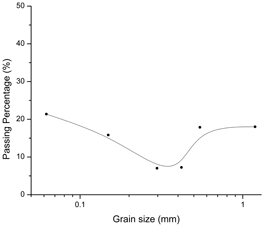Separates granular materials according to their grain size by means of mechanical sieving.
dating
morphology
technology
origin
composition
alteration

Mortar

Stone
Mortar & Plaster
A mortar is characterized by its 2 major components: the lime binder and the aggregates.
Granulometric analysis of the aggregate grains allows the typological differentiation of mortars as well as building phases within a building.
In some unusual cases it may offer direct assignment of mortars in a wider chronological and architectural period.

Granulometry graph. Image by Nora Pérez Castellanos
Granulometry is a simple physical method for particle size analysis of granular materials, very diffused in mortar characterization as it can measure the included aggregates’ size in order to identify the type of mortar we are dealing with. Especially useful also for earthen architecture (earthen mortars, earth blocks, adobe, rammed earth, cob) both for analyses of original materials and for the determination of the granulometric distribution of restoration materials. Produces a granulometric curve, expressing weight percentage of the grain size range.
accuracy
time
cost
in situ
invasive
destructive
A way to investigate granular materials is by measuring their grain sizes by means of mechanical sieving. Sieves display meshes* of diff erent sizes through which grains of different diameters pass. This way grains are separated and categorized according to both their size and their weight distribution. Once the grains have been separated, a granulometric curve, expressing weight percentage as a function of grain size range, is obtained